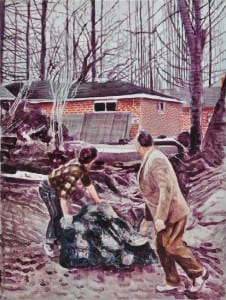Modern Art in Britain: Present Tense at Swindon Museum & Art Gallery
Posted on by Fay Curtis.
Sophie Cummings, Curator, Swindon Museum & Art Gallery

Fear and Possibility by Greg Rook, © the artist
Present Tense showcases contemporary painting and photography from the Swindon Collection of Modern British Art. It takes place at Swindon Museum & Art Gallery and features work by Lisa Milroy, Steven Pippin, Maggi Hambling and Jeffery Camp.
This is the most challenging exhibition shown in Swindon in the last few years. The works touch on murder and tragedy, traumatic memories, disorientation and dislocation. These are tough themes which we’ve tackled openly and honestly.
Putting it together has been a really interesting experience. Swindon is loaning almost fifty modern British works to the other Frameworks partners. Combined with the response to Turner: Watercolours from the West, it seemed the right time to focus on our contemporary works and offer our visitors something very different. It also offered an opportunity to break down some of the assumptions that act as a barrier between visitors and contemporary art. The exhibition is loosely themed to help visitors sport contrasts and links between very different types of work.
‘Contemporary’ is a broad chronological term, which can be recent or of the current time. It can also apply to the ‘post-modern’ period. We have used the mid-1980s onwards as this time corresponds with several major cultural and social shifts. These include the break-up of the Soviet Union, the development of new technology such as mobile phones and personal computers, and periods of conservative political rule in the US and UK. Together these things seem to combine to define a new period, characterised by new attitudes in art, music, drama and fashion.
The most challenging works in the exhibition are taken from traumatic moments in modern history. Magnus Quaife’s watercolours, from his series ‘1968 and Other Myths’ depict moments from that tumultuous year. One watercolour shows a burning tank in the centre of Prague. While 1968 in Western Europe meant student protests in Paris and London, in Eastern Europe it meant the violent put-down of an attempted revolution in Czechoslvakia. Quaife’s watercolour, with its thin layers of monochrome wash, is tinged with nostalgia and melancholia. The memory fades upon the paper and keeps the viewer at a distance from the traumatic event.
Robert Priseman’s ‘Home: A Series’ comprises 6 small paintings of houses in which murders and kidnappings have taken place. His series tries to investigate how the home, a place of comfort and sanctuary, can be distorted into a place of violence and terror.
Both Quaife and Robert Priseman are working from found images. They are following the tradition set by Pop Artists like Richard Hamilton and the Camden Town School painter Walter Sickert (both featured in the show at the Holburne Museum). Modern art in Britain is made up of links, influences, connections, conflicts and relationships, which should make for five rich and interlinked displays.
I hope visitors can see all five exhibitions as they contain some truly great modern art works. I’m interested to see how works from Swindon’s collection relate to other museums’ collections. I’m also excited to see how visitors respond to the works in our exhibition, some of which haven’t been on display for over 15 years.
More Frameworks posts
Read more about the Frameworks: Great Art in the West partnership.
Read about An Open Window arriving at The Wilson.
Read about Modern Art in Britain: ‘The Human Clay’ at Victoria Art Gallery, alongside ‘Beryl Cook: Intimate Relations’
Main image: Rings and Strings and Things by John Greenwood, 2000, © the artist